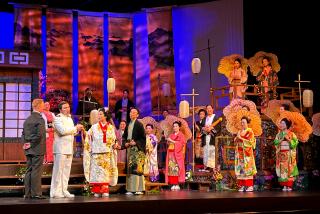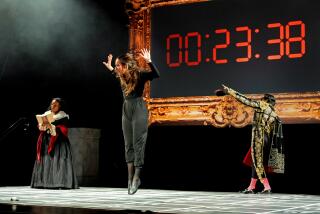MUSIC AND OPERA REVIEWS : Glass and ‘Powaqqatsi’: Energetic, Depressing
- Share via
Philip Glass’ detractors often warn concertgoers to bring NoDoz to performances by the composer’s Ensemble. But Glass’ advocates need no help staying alert when his music is played; they find interest, even subtext, where others hear only noodling.
Staying happy at a Glass performance is another matter. For all the upbeat, hard-won wisdom, worldliness and no-nonsense optimism often demonstrated by Glass the professional composer, his works sometimes remind us that this planet, being both polluted and crowded, can be a miserable place.
Such reminders constitute the bulk of Godfrey Reggio’s 1988 film, “Powaqqatsi,” for which Glass wrote the score--the piece is the second in a filmic trilogy begun with “Koyaanisqatsi” in 1983.
Seeing “Powaqqatsi,” with live accompaniment provided by the 12-member Philip Glass Ensemble, in Royce Hall, Saturday night, became a depressing experience.
Not because of Glass’ joyously tonal, craftily integrated, sometimes folk-inspired score--here using both amplification and taped additions (the children’s choir). In this music there is much pleasure and poetry, as well as technical skill. Indeed, so tightly constructed and attractive does this tuneful score become that it may live up to some observers’ assessment of it as the composer’s finest work in several years. For the prolific, Brahms-steady creator, that is saying a lot.
Without resort to describing the often-disturbing, sometimes beauteous, visual content of the film--it has been reviewed widely by specialists in that field--one can note that the aural counterpoint to the wordless viewing carries both subtleties and contradictions, making the total experience, for one observer, measurably more rich and varied than the same experience of “Koyaanisqatsi.”
Conducted by Michael Riesman, who led the ensemble on the original film and CD, the dozen players--including, of course, the composer, on keyboards--gave what appeared to be an authentic and energetic reading filled with careful detailing, quiet balances and full-throated sound-peaks before a full house in the UCLA facility. When those powerful climaxes arrived, two-thirds of the way through the 88-minute work, Royce Hall, the building, seemed constrained to contain them.
More to Read
The biggest entertainment stories
Get our big stories about Hollywood, film, television, music, arts, culture and more right in your inbox as soon as they publish.
You may occasionally receive promotional content from the Los Angeles Times.










